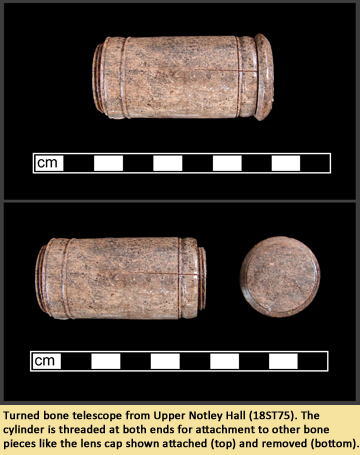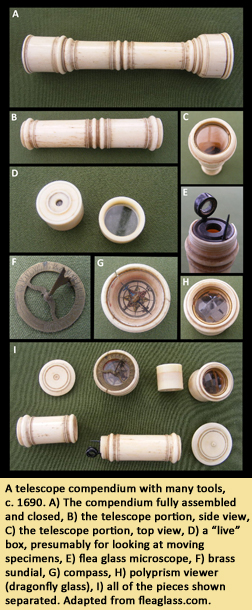Take a Closer Look at this 18th-Century
Needle Case Telescope!
September 2013
By Sara Rivers Cofield, MAC Lab Curator of Federal Collections
 Sometimes curators are delighted to discover that they are wrong, and this Curator’s Choice is devoted to just such a case. I recently pulled a number of artifacts for a gathering of colleagues on the topic of needlework, and one of the artifacts in question was a lovely turned bone item that has been interpreted as an 18th-century needle case since it was recovered in 1981. The hollow bone cylinder has two threaded ends, one of which has a lid that can still be screwed onto it. I wanted to know what went on the other end; after all why would a needle case need to open on two sides? A Google image search for bone needle cases resulted in a lot of hits, but they were either elaborately decorative or too skinny to match my example. So I made a more generic search for "18th-century turned bone." This time I found my object, but it wasn’t a needle case at all — it was a telescope!
Sometimes curators are delighted to discover that they are wrong, and this Curator’s Choice is devoted to just such a case. I recently pulled a number of artifacts for a gathering of colleagues on the topic of needlework, and one of the artifacts in question was a lovely turned bone item that has been interpreted as an 18th-century needle case since it was recovered in 1981. The hollow bone cylinder has two threaded ends, one of which has a lid that can still be screwed onto it. I wanted to know what went on the other end; after all why would a needle case need to open on two sides? A Google image search for bone needle cases resulted in a lot of hits, but they were either elaborately decorative or too skinny to match my example. So I made a more generic search for "18th-century turned bone." This time I found my object, but it wasn’t a needle case at all — it was a telescope!
Five similar telescopes have been recovered in Amsterdam, where they were presumably manufactured and sold. Our supposed needle case looked just like the Amsterdam telescopes, right down to the dimensions and the lid. The telescopes are made from the metatarsal bone of the cow, which only allowed up to 10 cm of bone suitable for turning. Any telescope intended to be longer could be threaded at the middle to fit another piece. Each end would have a glass lens held in place with a metal ring and an end cap to protect the lens when not in use. One lens was concave and the other was convex. This arrangement achieved relatively weak magnification, but unlike more powerful telescopes of the period, the image you saw would not appear upside down (Rijkelijkhuizen 2011).
 Such short telescopes would not be strong enough for use in astronomy or ship navigation, but their small size and versatility made them handy for personal use. In some cases the telescope function was only one of many tools ingeniusly nested into a compact bone cylinder. In addition to the telescope, multi-purpose compendiums might include small lenses that acted as a microscope or "flea glass", compasses, sundials, and "live" boxes to hold a small specimen for viewing. Each portion of the instrument could be accessed or put away simply by screwing or unscrewing different sections of the compendium (for more examples, see Chrisites.com, fleaglass.com, and vanleesantiques.com).
Such short telescopes would not be strong enough for use in astronomy or ship navigation, but their small size and versatility made them handy for personal use. In some cases the telescope function was only one of many tools ingeniusly nested into a compact bone cylinder. In addition to the telescope, multi-purpose compendiums might include small lenses that acted as a microscope or "flea glass", compasses, sundials, and "live" boxes to hold a small specimen for viewing. Each portion of the instrument could be accessed or put away simply by screwing or unscrewing different sections of the compendium (for more examples, see Chrisites.com, fleaglass.com, and vanleesantiques.com).
The telescope in our collection was excavated from the south yard of a late 18th-century house that still stands in St. Mary's County (Site 18ST75, Upper Notley Hall). Archaeologists located an earlier foundation that was probably constructed after 1720 and demolished by around 1775 when the current structure was built. The telescope was in an undisturbed trash deposit that is believed to represent demolition debris from the earlier house (Pogue 1981). Unfortunately, little is known of the occupants of Notley Hall in the 18th century because an 1831 courthouse fire destroyed the early property records (Pogue 1981).
Since we can’t connect the telescope to any particular people, it is hard to say what this object means in the context of Maryland history. Certainly it is indicative of the rise of scientific thinking that led the 18th century to be nicknamed the "Age of Reason" and "The Enlightenment." We know that other Maryland settlers took an interest in science. For example, one late 17th-century resident of Calvert County was an avid astronomer who grew up in the same household as Isaac Newton and contributed data from his astronomical observations to Newton’s works (Rose and Marti 1984). Perhaps the inhabitants of Notley Hall were participants in similar scientific endeavors and they bought a relatively small and versatile tool to aid their efforts. Then again, maybe they just wanted to spy on each other. Either way, we can say that this telescope was probably not used to store pins or needles, so at least we’ve corrected that decades-old conclusion. Furthermore, my curatorial instincts will no longer jump to the terms “needle case” or “utensil handle” every time I see a hollow bone object. I won’t go straight to “telescope” as an ID either though. Instead, I will go to library books, Google images, antique store websites, and any other resource that can show me old objects as they looked when they were whole. I’m looking forward to being wrong more often, since sometimes that means an artifact is so much more exciting than we originally thought.
| References |
|
| Christies.com |
| 2013 |
An Unusual Late 18th-Century [?]English Turned Bone Telescope, Flea Glass and Live Box Compendium. Web resource, http://www.christies.com/lotfinder/lot/an-unusual-late-18th-century-english-turned-bone-3103884-details.aspx?from=salesummary&intObjectID=3103884&sid=b6c48a49-4373-4903-bcc1-a88cbd968dbd, accessed 8/26/2013. |
|
| Fleaglass.com |
| 2011 |
Early Bone Compendium. Web resource, http://www.fleaglass.com/index.php?a=2&b=7526, accessed 8/26/2013. |
|
| Pogue, Dennis |
| 1981 |
Archaeological Investigations at Notley Hall (18ST75), St. Mary’s County, Maryland. Maryland Historical Trust Manuscript Series, No. 21 |
|
| Rijkelijkhuizen, Marloes J. |
| 2011 |
Bone Telescopes from Amsterdam. Journal of Archaeology in the Low Countries 3-1 (November 2011). Web resource, http://dpc.uba.uva.nl/jalc/03/nr01/a05, accessed 8/26/2013. |
|
| Rose, Lou and Michael Marti |
| 1984 |
Arthur Storer of Lincolnshire, England, and Calvert County, Maryland: Newton’s Friend, Star Gazer, and Forgotten Man of Science in Seventeenth-Century Maryland. Calvert County Historical Society. Maryland Printing and Graphics, Inc.: Dunkirk, Maryland. |
|
| Vanleesantiques.com |
| n.d. |
Fleaglass Microscope and Telescope Compendium. Web resource, http://www.vanleestantiques.com/object.php?id=1266, accessed 8/26/2013. |
|